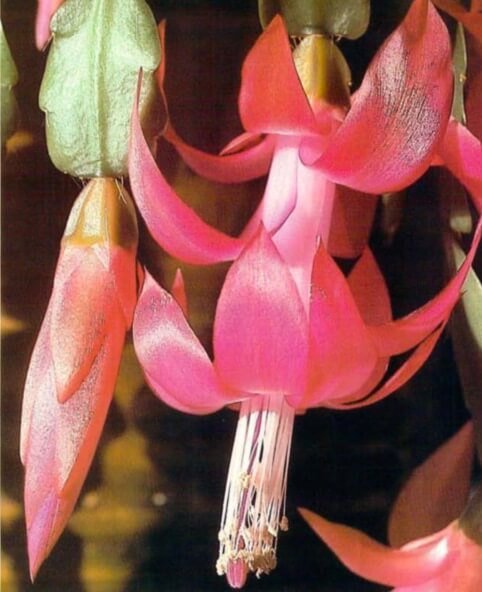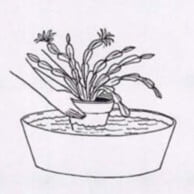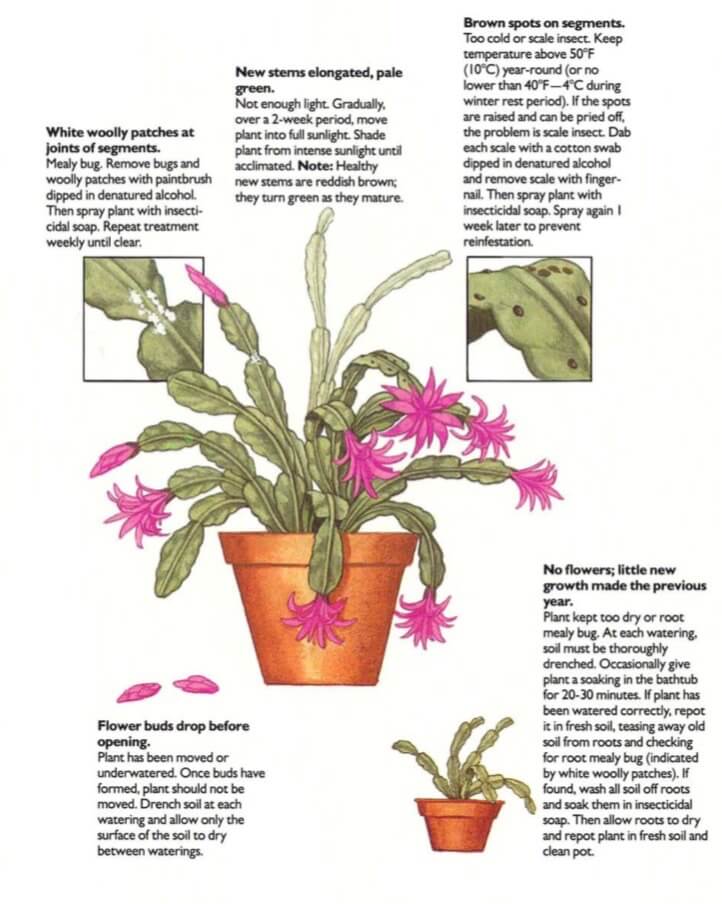[Ebook Việt Hoá] The Instant Guide to Healthy Houseplants (Hướng dẫn tức thời để chăm cây trong nhà khoẻ mạnh), Chi Parodia - Chi Notocactus
[Ebook Việt Hoá] The Instant Guide to Healthy Houseplants: Rhipsalidopsis gaertneri (Easter cactus)
- Nguồn: [Ebook Việt Hoá] The Instant Guide to Healthy Houseplants (Hướng dẫn tức thời để chăm cây trong nhà khoẻ mạnh)
- Biên tập: Dũng Cá Xinh
- Biên dịch: Team Codai.net
English
With a little care and attention, this popular cactus will grow well and produce showers of deep pink flowers at Easter time. In the wild in the jungles of Brazil, Rhipsalidopsis gaertneri grows as an epiphyte, so it requires different treatment from its more prickly desert relatives. Easter cactus prefers more humus in its potting mix, more frequent misting, and a higher minimum temperature of about 50°F (10°C) than most other cacti. After the plant develops buds, it should not be moved.

Light
Needs 3 hours a day of full sunlight year-round. Protect from intense sunlight.
Temperature
Keep temperature above 50°F (10°C) year-round. Plant will tolerate a low temperature of 40°F (4°C) if kept fairly dry.
Feeding
In spring and summer. apply high-potash fertilizer (such as used for tomatoes) at every other watering.
Soil
Use peat-based soil or wellrotted leaf mold. No additional drainage material is necessary.
Repotting
Repot annually, after flowering, in next size pot until plant is in as-in (13-cm) pot. Then repot every 2-3 years.
Humidity
Mist plant at least once a week with tepid soft water (preferably rainwater).
Water
In spring and summer, water thoroughly about once a week, allowing soil to dry out between waterings. Occasionally, place pot in a tub of water for 20-30 minutes. In fall and winter, water about every 14 days if temperature is above 50°F(10°C). If temperature is under 50°F (10°C). do not water.

What Goes Wrong

- White woolly patches at joints of segments: Mealy bug. Remove bugs and woolly patches with paintbrush dipped in denatured alcohol. Then spray plant with insecticidal soap. Repeat treatment weekly until clear.
- New stems elongated, pale green: Not enough light. Gradually. over a 2-week period. move plant into full sunlight. Shade plant from intense sunlight until acclimated. Note: Healthy
new stems are reddish brown; they turn green as they mature. - Brown spots on segments: Too cold or scale insect. Keep temperature above 50°F (10°C) year-round (or no lower than 40°F (4°C) during winter rest period). If the spots are raised and can be pried off. the problem is scale insect. Dab each scale with a cotton swab dipped in denatured alcohol and remove scale with fingernail. Then spray plant with insecticidal soap. Spray again 1 week later to prevent re infestation.
- Flower buds drop before opening: Plant has been moved or underwatered. Once buds have formed. plant should not be moved. Drench soil at each watering and allow only the surface of the soil to dry between waterings.
- No flowers; little new growth made the previous year: Plant kept too dry or root mealy bug. At each watering. soil must be thoroughly drenched. Occasionally give plant a soaking in the bathtub for 20-30 minutes. If plant has been watered correctly. repot it in fresh soil. teasing away old soil from roots and checking for root mealy bug (indicated by white woolly patches). If found. wash all soil off roots and soak them in insecticidal soap. Then allow roots to dry and repot plant in fresh soil and clean pot.
Tiếng Việt
Với một chút lưu ý về chăm sóc, loài xương rồng phổ biến này sẽ phát triển tốt và cho ra những chùm hoa màu hồng đậm vào thời điểm Lễ Phục sinh. Trong khu rừng rậm tự nhiên của Brazil, Rhipsalidopsis gaertneri phát triển như một loài thực vật biểu sinh, vì vậy nó cần được chăm sóc khác với những họ hàng sa mạc gai góc của nó. Cây xương rồng Phục sinh thích nhiều mùn hơn trong hỗn hợp đất của nó, phun sương thường xuyên hơn và nhiệt độ tối thiểu cao hơn 50 ° F (10 ° C) so với hầu hết các loại xương rồng khác. Sau khi cây phát triển chồi không nên di chuyển.

Ánh sáng
Mỗi ngày cần 3 giờ đầy đủ ánh sáng mặt trời. Bảo vệ khỏi ánh nắng gay gắt.
Nhiệt độ
Giữ nhiệt độ trên 50 ° F (10 ° C) quanh năm. Cây sẽ chịu được nhiệt độ thấp 40 ° F (4 ° C) nếu được giữ khá khô.
Bón phân
Vào mùa xuân và mùa hè bón phân có hàm lượng kali cao (chẳng hạn như dùng cho cà chua) vào mỗi lần tưới nước.
Đất
Sử dụng đất làm từ than bùn hoặc nấm mốc lá đã mục nát. Không cần thêm nguyên liệu thoát nước.
Thay chậu
Thay chậu hàng năm, sau khi cây ra hoa, trong chậu cỡ tiếp theo cho đến khi cây ở trong chậu 5 inch (13 cm). Sau đó thay chậu 2-3 năm một lần.
Độ ẩm
Phun sương cho cây ít nhất một lần một tuần với nước mềm loãng (tốt nhất là nước mưa).
Nước
Vào mùa xuân và mùa hè, tưới nước kỹ khoảng một lần một tuần, để cho đất khô đi giữa các lần tưới. Thỉnh thoảng, đặt chậu vào bồn nước trong 20-30 phút. Vào mùa thu và mùa đông, tưới nước khoảng 14 ngày một lần nếu nhiệt độ trên 50 ° F (10 ° C). Nếu nhiệt độ dưới 50 ° F (10 ° C). không tưới nước.

Những vấn đề có thể xảy ra

- Các mảng lông tơ màu trắng ở các khớp lá: Rệp sáp. Loại bỏ chúng và các mảng len bằng cọ nhúng trong cồn biến tính. Sau đó phun xà phòng diệt côn trùng cho cây. Lặp lại điều trị hàng tuần cho đến khi khỏi hẳn.
- Thân mới dài ra, màu xanh nhạt: Không đủ ánh sáng. Dần dần trong khoảng thời gian 2 tuần, chuyển cây vào nơi có ánh sáng mặt trời đầy đủ. Che bóng cho cây khỏi ánh nắng gay gắt cho đến khi thích nghi. Lưu ý: Thân mới khỏe có màu nâu đỏ; chúng chuyển sang màu xanh lục khi chúng trưởng thành.
- Các đốm nâu trên các đoạn cây: Quá lạnh hoặc có vảy côn trùng. Giữ nhiệt độ trên 50 ° F (10 ° C) quanh năm (hoặc không thấp hơn 40 ° F (4 ° C) trong thời gian nghỉ đông). Nếu các đốm nổi lên và có thể bị cạy ra thi vấn đề là do côn trùng có vảy. Dùng tăm bông nhúng vào cồn biến tính để chấm từng đốm và dùng móng tay loại bỏ chúng. Sau đó phun xà phòng diệt côn trùng cho cây và 1 tuần sau phun lại để ngăn ngừa bệnh tái nhiễm.
- Nụ hoa rụng trước khi nở: Cây đã được di chuyển hoặc tưới nước. Khi chồi đã hình thành, cây không nên được di chuyển. Xới đất mỗi lần tưới và để bề mặt đất khô giữa các lần tưới.
- Không có hoa; Cây mới mọc ít năm trước: Cây để quá khô hoặc bị rệp sáp ở rễ. Ở mỗi lần tưới và đất phải được làm ướt kỹ. Thỉnh thoảng cho cây ngâm trong nước khoảng 20-30 phút. Nếu cây đã được tưới nước đúng cách, thay chậu vào đất tươi rồi xới đất cũ khỏi rễ và kiểm tra rệp sáp ở rễ (lộ ra các mảng len màu trắng). Nếu được tìm thấy rửa sạch đất bám trên rễ và ngâm trong xà phòng diệt côn trùng. Sau đó để cho rễ khô và thay chậu vào đất sạch và chậu sạch.



